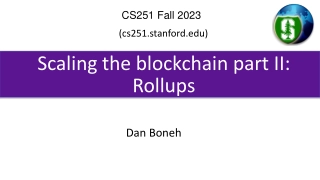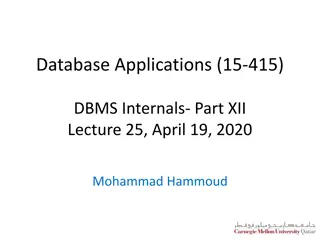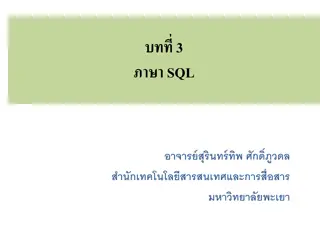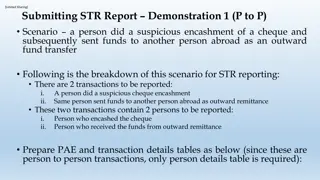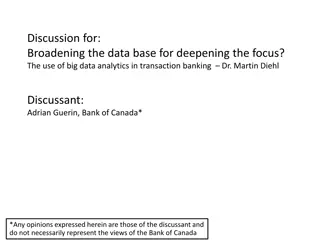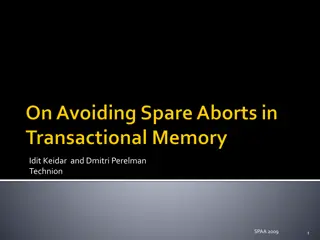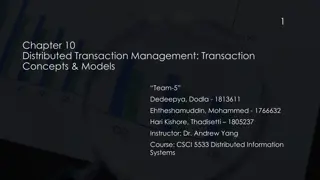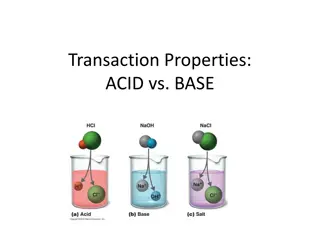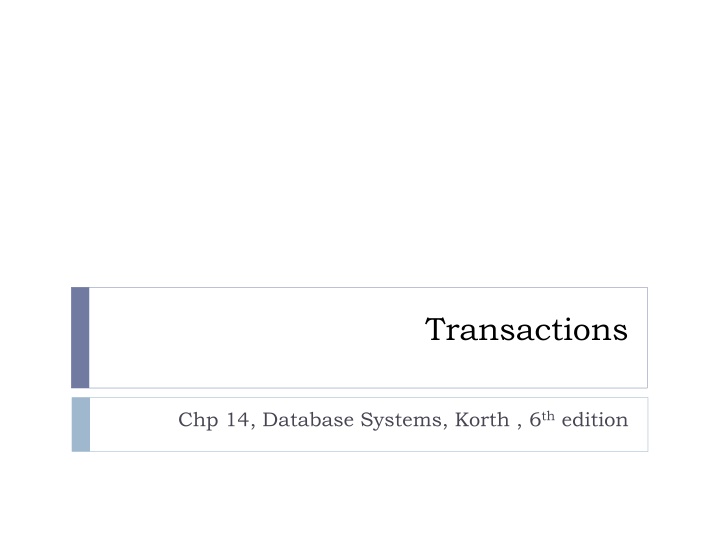
Transactions in Database Systems
Explore the concept of transactions in database systems, including what transactions are, their properties (ACID), and the responsibilities for ensuring these properties. Learn about a simple transaction model in a bank application scenario. Sudha Bhagavatheeswaran, from SIES College of Arts, Science & Commerce, provides insightful explanations and examples throughout.
Download Presentation

Please find below an Image/Link to download the presentation.
The content on the website is provided AS IS for your information and personal use only. It may not be sold, licensed, or shared on other websites without obtaining consent from the author. If you encounter any issues during the download, it is possible that the publisher has removed the file from their server.
You are allowed to download the files provided on this website for personal or commercial use, subject to the condition that they are used lawfully. All files are the property of their respective owners.
The content on the website is provided AS IS for your information and personal use only. It may not be sold, licensed, or shared on other websites without obtaining consent from the author.
E N D
Presentation Transcript
Transactions Chp 14, Database Systems, Korth , 6thedition
Transactions What is a transaction? Collections of operations that form a single logical unit of work are called transactions. A transaction is a unit of program execution that accesses and possibly updates various data items. Initiated by SQL or C++ or Java with embedded database accesses in JDBC or ODBC. Begin transaction transaction operations End transaction This collection of steps must appear to the user as a single, indivisible unit Sudha Bhagavatheeswaran, Department of Information Technology, SIES College of Arts, Science & Commerce (Autonomous)
Transactions ACID properties of a Transaction Atomicity :- Either all operations of the transaction are reflected properly in the database, or none are. Consistency :- Execution of a transaction in isolation (that is, with no other transaction executing concurrently) preserves the consistency of the database. Isolation :- Even though multiple transactions may execute concurrently, the system guarantees that, for every pair of transactions Ti and Tj , it appears to Ti that either Tj finished execution before Ti started or Tj started execution after Ti finished. Thus, each transaction is unaware of other transactions executing concurrently in the system. Durability. :- After a transaction completes successfully, the changes it has made to the database persist, even if there are system failures. Sudha Bhagavatheeswaran, Department of Information Technology, SIES College of Arts, Science & Commerce (Autonomous)
Transactions Ensuring ACID properties Ensuring consistency for an individual transaction is the responsibility of the application programmer who codes the transaction. Ensuring atomicity is the responsibility of a component of the database called the recovery system Ensuring durability is the responsibility of a component of the database called the recovery system Ensuring the isolation property is the responsibility of a component of the database system called the concurrency-control system Sudha Bhagavatheeswaran, Department of Information Technology, SIES College of Arts, Science & Commerce (Autonomous)
Transactions A Simple Transaction Model A simple bank application consisting of several accounts and a set of transactions that access and update those accounts. Transactions access data using two operations: read(X), which transfers the data item X from the database to a variable. write(X), which transfers the value in the variable X in the main-memory buffer of the transaction that executed the write to the data item X in the database. Sudha Bhagavatheeswaran, Department of Information Technology, SIES College of Arts, Science & Commerce (Autonomous)
Transactions A Simple Transaction Model Let Ti be a transaction that transfers $50 from account A to account B. This transaction can be defined as: Ti : read(A); A := A 50; write(A); read(B); B := B + 50; write(B). Sudha Bhagavatheeswaran, Department of Information Technology, SIES College of Arts, Science & Commerce (Autonomous)
Transactions Transaction Model - states Sudha Bhagavatheeswaran, Department of Information Technology, SIES College of Arts, Science & Commerce (Autonomous)
Transactions Transaction Model - states Active, the initial state; the transaction stays in this state while it is executing. Partially committed, after the final statement has been executed. Failed, after the discovery that normal execution can no longer proceed. Aborted, after the transaction has been rolled back and the database has been restored to its state prior to the start of the transaction. Committed, after successful completion. A transaction is said to have terminated if it has either committed or aborted. Sudha Bhagavatheeswaran, Department of Information Technology, SIES College of Arts, Science & Commerce (Autonomous)
Transactions Example Transaction T1 transfers $50 from account A to account B. T1: read(A); A := A 50; write(A); read(B); B := B + 50; write(B). Transaction T2 transfers 10 percent of the balance from account A to account B. T2: read(A); temp := A * 0.1; A := A temp; write(A); read(B); B := B + temp; write(B). current values of accounts A and B are $1000 and $2000 Sudha Bhagavatheeswaran, Department of Information Technology, SIES College of Arts, Science & Commerce (Autonomous)
Transactions Schedule 1 - T1 is followed by T2. The accounts A and B, after the execution takes place, are $855 and $2145, respectively. The sum A + B is preserved final values of 1000 950 2000 2050 950 A= 950 B= 2050 95 855 2050 2145 A= 855 B= 2145 Sudha Bhagavatheeswaran, Department of Information Technology, SIES College of Arts, Science & Commerce (Autonomous)
Transactions Schedule 2 - T2 is followed by T1. 1000 100 The final values of accounts A and B are $850 and $2150, respectively. The sum A + B is preserved 900 2000 2100 900 A= 900 B= 2100 850 2100 2150 A= 850 B= 2150 Sudha Bhagavatheeswaran, Department of Information Technology, SIES College of Arts, Science & Commerce (Autonomous)
Transactions Schedule 3 a concurrent schedule The final values of accounts A and B, after the execution takes place, are $855 and $2145, respectively. The sum A + B is preserved 1000 950 950 95 855 2000 2050 2050 A= 855 B= 2050 95 2145 A= 855 B= 2145 Sudha Bhagavatheeswaran, Department of Information Technology, SIES College of Arts, Science & Commerce (Autonomous)
Transactions Schedule 4 a concurrent schedule (inconsistent state) 1000 950 The final values of accounts A and B are $950 and respectively. (inconsistent state) - the sum A + B is not preserved 1000 100 $2100, 900 2000 950 2000 2050 2100 A= 950 B= 2050 A= 950 B= 2100 2100 Sudha Bhagavatheeswaran, Department of Information Technology, SIES College of Arts, Science & Commerce (Autonomous)
Transactions Schedules The execution sequences are called schedules. They represent the chronological order in which instructions are executed in the system. Clearly, a schedule for a set of transactions must consist of all instructions of those transactions, and must preserve the order in which the instructions appear in each individual transaction. A schedule is the order in which the operations of multiple transactions appear for execution. Serial schedules are always consistent and Non-serial schedules are not always consistent. Sudha Bhagavatheeswaran, Department of Information Technology, SIES College of Arts, Science & Commerce (Autonomous)
Transactions Serial Schedules In serial schedules, All the transactions execute serially one after the other. When one transaction executes, no other transaction is allowed to execute. Schedule 1 and 2 are serial schedules. Both are consistent. Each serial schedule consists of a sequence of instructions from various transactions, where the instructions belonging to one single transaction appear together in that schedule Sudha Bhagavatheeswaran, Department of Information Technology, SIES College of Arts, Science & Commerce (Autonomous)
Transactions Non- Serial Schedules In non-serial schedules, Multiple transactions execute concurrently. Operations of all the transactions are inter leaved or mixed with each other. Schedule 3 and 4 are non-serial schedules Schedule 3 is consistent Schedule 4 is not consistent Therefore, non-serial schedules are not always consistent Sudha Bhagavatheeswaran, Department of Information Technology, SIES College of Arts, Science & Commerce (Autonomous)
Transactions Schedule1 Schedule 3 Sudha Bhagavatheeswaran, Department of Information Technology, SIES College of Arts, Science & Commerce (Autonomous)


